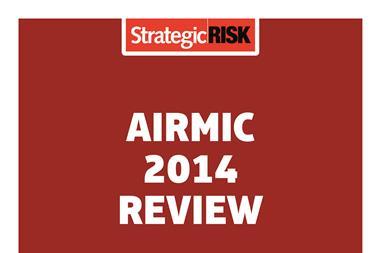Airmic’s chief executive John Hurrell and its technical director Paul Hopkin review the association’s latest products as the conference comes to an end today

Every Airmic conference sees the launch of new products and practical guides to help risk managers and insurance buyers with their day-today responsibilities.
The association has already launched its long-awaited global compliance database a few weeks before the start of the conference, and revealed a practical guide on insurance efficacy and a report that provides practical steps to dealing with some of the risks featured in the World Economic Forum’s Global Risks Report.
StrategicRISK spoke to John Hurrell, the association’s chief executive and Paul Hopkin, technical director, to find out more.
1. Global compliance database
For risk managers and insurance buyers working for multinationals, complying with laws that govern global insurance programmes is a significant challenge. Many rules also differ from country to country and they often change without warning.
The Insight Risk Manager database aims to help risk managers understand the regulatory requirements for their global insurance programmes.
Axco was commissioned to develop the database. So far, the database will enable users to view the regulatory requirements in 30 initial countries. The system will then provide information, for example, on the legal framework for non-admitted insurance, reinsurance details and information about the regulator.
Although insurers and brokers have maintained their own databases, Hopkin says Airmic’s database is unique because it has been developed with the insurance buyer in mind.
2. Efficacy guide
Airmic’s guide to insurance efficacy promises to “help buyers achieve greater coverage, contract and claims certainty,” says Hopkin.
“We believe at Airmic that the provisions of the Marine Insurance Act 1906 are not equitable, especially in relation to the insurance remedies.
“Some aspects of the Act are detrimental to buyers. For example, if the insurance buyer does not fully disclose all material facts, even if the non-disclosure is accidental, the remedy for the insurance company is avoidance of the policy ab initio or from inception.
For greater contract certainty, Hopkin highlights three key steps:
1. “Make sure you obtain your insurance policy on the day or before inception. We are not convinced that the contact certainty initiative from the
Financial Services Authority some years ago has worked to the benefit of the buyers – receiving the document 30 days after the policy has started is too late.”
2. “Review the wording to ensure it gives you the coverage you require and to ensure there are no gaps in cover.”
3. “Make sure you have identified what you have to do to get your claims paid efficiently, such as prompt notification of the claim, supply of full information to underwriters for example.”
3. Responding to Global Risks
In conjunction with the Institute of Directors, PwC, Marsh and Zurich, Airmic will publish a guide that builds on the World Economic Forum’s Global Risk Report. It will provide practical steps to managing and mitigating these risks.
The guide is set out in nine chapters, exploring areas such as managing global risks – how boards must take steps to mitigate these risks; how to deal with logistical nightmares in infrastructure and the supply chain; and technological risks.
Hurrell says: “The guide encourages the reader to think about their business dependencies. In other words, it is not only about identifying the risk, whether it is an earthquake, a flood, or tsunami, but to focus on, for instance, what their infrastructures are dependent on, what will stop their supply chains working, what will stop their technology working, and to assess how effective their plan B is.
“Take the Icelandic volcanic ash as an example. Many risk managers were asking, how could we have spotted that risk? The answer is perhaps that businesses don’t have to spot all the risks, what they have to do is spot their dependencies. In this example, air travel was implicated. So, if your business depends on air travel, do you have a plan B that enables you to carry on working?”
4. in the pipeline…
Airmic is currently working on three other practical guides. These will be available later this year:
1. The first guide aims to assess the value of chief risk officers (CROs). Currently, CROs are predominately appointed in financial institutes but few other businesses will recruit a risk manager at this level. Airmic will be working with the Tomorrow’s Company to investigate the benefits CROs bring to businesses and how this is measured.
2. Airmic is working with the Chartered Institute of Management
Accountants to try and link risk planning and risk mapping to the corporate business model. “To make the risk map as relevant as possible, it should relate closely to the critical ingredient of the corporate business model,” Hurrell says.
3. It is also working with human resources directors to assess whether they have a role in risk management. “In our research, we found that the fundamental underlying causes of risk is basically human failure in some way or another. So we’re looking at whether there is a role for HR directors in thinking about risk.”




















No comments yet